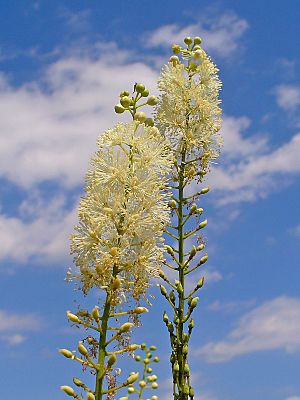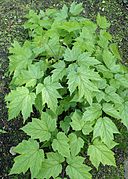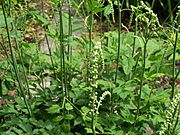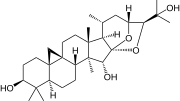Black cohosh facts for kids
Actaea racemosa, also known as black cohosh, black bugbane, black snakeroot, or fairy candle, is a type of flowering plant. It belongs to the Ranunculaceae family, which includes buttercups. This plant grows naturally in eastern North America, from southern Ontario down to central Georgia, and west to Missouri and Arkansas. You can often find it in different woodland areas, especially in small clearings.
Long ago, Native Americans used the roots and underground stems (rhizomes) of black cohosh in their traditional remedies. Today, some people make extracts from black cohosh to use as herbal supplements. However, scientists are still studying black cohosh, and it is not officially recommended as a safe or effective treatment for health problems.
Quick facts for kids Black cohosh |
|
|---|---|
 |
|
| Inflorescence | |
| Conservation status | |
| Scientific classification | |
| Genus: |
Actaea (plant)
|
| Species: |
racemosa
|
| Synonyms | |
|
Synonymy
Cimicifuga repens (L) Nutt
Cimicifuga americana Muhl Actaea gyrostachya Wender Actaea monogyna Walter Actaea orthostachya Wender Botrophis actaeoides Raf ex Fisch & CA Mey Botrophis pumila Raf Botrophis serpentaria Raf |
|
Contents
Plant Classification
Scientists group living things into categories, and this is called taxonomy. The black cohosh plant has had a bit of a confusing history in how it's been classified.
Long ago, a famous scientist named Carl Linnaeus first placed this plant in the Actaea group. He looked at its flowers and seeds to decide this. Later, another scientist, Thomas Nuttall, changed its classification to the Cimicifuga group. He made this decision based on the dry fruits the plant produced.
However, more recent studies, looking at the plant's features and its genes, show that black cohosh is actually more closely related to other plants in the Actaea group. Because of this, scientists have gone back to Linnaeus's original idea, and the plant is now officially known as Actaea racemosa.
It's important to know that "blue cohosh" (Caulophyllum thalictroides) is a different plant. Even though it has a similar common name, it belongs to a different plant family, the Berberidaceae. It is not closely related to black cohosh.
What Black Cohosh Looks Like
Black cohosh is a smooth, herbaceous perennial plant. This means it's a plant that doesn't have a woody stem and lives for more than two years. It grows large, compound leaves from an underground stem called a rhizome. The plant can reach a height of about 25 to 60 centimeters (10 to 24 inches).
The leaves at the bottom of the plant can be up to 1 meter (3 feet) long and wide. They are made up of many smaller leaflets, arranged in groups of three. The edges of these leaflets are rough and toothed.
The plant produces its flowers in late spring and early summer. These flowers grow on a tall stem that can be 75 to 250 centimeters (2.5 to 8 feet) tall. The flowers form long clusters called racemes, which can be up to 50 centimeters (20 inches) long.
Black cohosh flowers are unique because they don't have petals or sepals (the leaf-like parts that usually protect a flower bud). Instead, they have tight clusters of 55 to 110 white stamens, which are the parts that produce pollen. These stamens surround a white stigma, which is the part that receives pollen. The flowers have a distinct, sweet but somewhat strong smell. This smell helps attract flies, gnats, and beetles, which help pollinate the plant.
After the flowers bloom, the plant produces a dry follicle fruit. This fruit is about 5 to 10 millimeters (0.2 to 0.4 inches) long. Each fruit has one section (carpel) and contains several seeds.
Growing Black Cohosh
Actaea racemosa grows best in soil that stays moist and is fairly rich. It produces tall, tapering clusters of white flowers in mid-summer. These flowers grow on thin, dark purple stems. When you get close, the flowers have a slightly unpleasant, medicinal smell, which is why one of its common names is "Bugbane."
Even after the flowers dry, the seed heads remain attractive in the garden for many weeks. The plant's deeply cut leaves, which can be a beautiful burgundy color in the "atropurpurea" type, add visual interest to gardens. Black cohosh is a popular garden perennial, especially in places where summer heat and dryness don't cause it to die back. It has even received the Royal Horticultural Society's Award of Garden Merit, which means it's a great plant for gardens.
Historical Uses
Native Americans used black cohosh for various traditional remedies. When European settlers arrived in the U.S., they also began to use black cohosh. The plant was even listed in the U.S. Pharmacopoeia, a book of recognized medicines, under the name "black snakeroot." In the 1800s, people used the root for different purposes, including treating pain.
Today, black cohosh is sometimes sold as a dietary supplement. However, it's important to know that there isn't strong scientific proof that it works as a medicine for health problems.
Safety Information
Scientists have not published many detailed studies on the long-term safety of using black cohosh. This is partly because much of the black cohosh used in products is gathered from the wild. Sometimes, other plant species can get mixed in with commercial black cohosh products.
Taking large amounts of black cohosh might cause some side effects. These can include feeling sick to your stomach (nausea), dizziness, changes in vision, a slower heart rate, and increased sweating.
Around the world, there have been some reports of liver problems, like hepatitis (liver inflammation), linked to black cohosh use. However, it's not clear if black cohosh directly caused these issues. Many people have taken black cohosh without any reported bad effects. Some studies have also found no evidence that black cohosh harms the liver.
Organizations like Cancer Research UK have mentioned that long-term use of black cohosh might cause changes in the womb lining. They also advise people with liver problems not to take it, as it could potentially harm the liver, though some research suggests this concern might not be true. In 2007, the Australian Government warned that black cohosh could rarely cause liver damage and should not be used without a doctor's guidance. Other studies suggest liver damage from black cohosh is unlikely.
Plant Chemicals
Black cohosh contains many natural chemicals called phytochemicals. These include polyphenols and compounds that act somewhat like estrogen. Scientists have looked into whether these compounds might help with certain symptoms, but high-quality research has not yet confirmed these effects.
Images for kids
See also
 In Spanish: Actaea racemosa para niños
In Spanish: Actaea racemosa para niños















